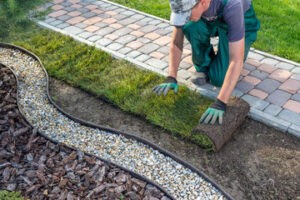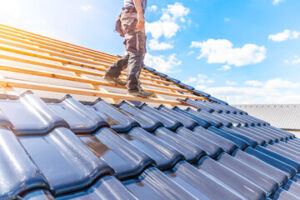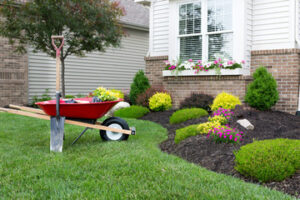How Landscaping Can Increase Your Home’s Curb Appeal and Value
Landscaping Boca Raton involves the design and implementation of outdoor environments that complement your home. It includes planting and maintaining a variety of plants, doing terrain assessments, and installing structures like patios, walkways, gardens, and fences.

Save your existing plants and repurpose existing hardscapes whenever possible. For example, if you have an ugly patio cover with ivy on it, consider replacing it with something more attractive like a climbing hydrangea or clematis.
1. Increase Your Home’s Value
Landscaping adds to your home’s curb appeal and can increase its value. It also helps to reduce your energy bills by shading your home in the summer and blocking cold winds in the winter. A well-designed landscape also reduces noise pollution and adds beauty to your neighborhood.
Landscapes can be made of both hardscape and softscape elements. Hardscapes include paving, pathways and patios, while softscapes are comprised of plants and flowers. Hardscaping provides unique textures that complement your plants and create focal points and defined areas.
Adding trees, shrubs and flowers to your yard can increase your property’s value, especially if they are colorful. These plants also act as natural pest repellents, with a variety of herbs emitting scents that are pleasant to humans but unpleasant for insects. They also help to improve air quality and are a great habitat for wildlife.
2. Increase Your Home’s Comfort
The outside of your home is the first thing potential buyers see and it’s important to leave a good impression. Landscaping can increase your home’s comfort and provide a place to relax. It also helps you save energy costs by providing shade in the summer and wind-blocking in winter.
Landscape design includes elements like pathways, driveways, retaining walls, water features and plants to create an attractive and harmonious outdoor environment. Landscapers assess the terrain and make adjustments to balance visual appeal with practical needs.
Grass and trees can provide fresh oxygen and reduce air pollution by absorbing carbon dioxide, reducing dust and smoke, and filtering water. They can even attract birds and other wildlife to your property. This is called synergy, and it’s when the combined effects of different components are greater than their individual parts.
3. Increase Your Home’s Value
Adding an outdoor oasis, like a new garden or patio, can increase your home’s value. By using high-quality materials and expert installation, you can create a landscape that will last for years to come.
The right landscaping can also make your home more energy efficient. Planting trees and bushes near windows will provide shade, which can reduce your energy costs. Using water features, such as fountains and waterfalls, can add interest and beauty to your yard while also decreasing soil erosion.
When choosing which landscaping features to incorporate, think about what would appeal most to potential buyers. Generally, homes with lush lawns and beautiful flower beds will have the most appeal. However, it’s important to strike a balance between nature and the house itself. If your backyard has an overabundance of vegetables, for example, this could deter some people from buying your home.
4. Increase Your Home’s Energy Efficiency
In today’s eco-conscious world, finding innovative ways to reduce energy consumption has become a top priority for many homeowners and businesses. One often overlooked method is through thoughtful landscaping.
Landscaping can improve energy efficiency by providing shade, reducing heat absorption, and increasing insulation. These effects can reduce the need for artificial cooling and heating, saving money and minimizing environmental impact.
Strategically planting deciduous trees on the south and west sides of your home can provide natural shading in summer, lowering air conditioning costs. Additionally, evergreens can shield your house in winter from cold wind gusts. In addition, plants that require less water help lower energy bills by reducing the amount of energy needed to pump and treat water. As an added benefit, native plants have evolved to fit the local climate and soil conditions, requiring less water and maintenance.
5. Increase Your Home’s Value
Landscaping can increase your home’s value by making it more appealing to potential buyers. In fact, research shows that well-manicured properties are valued 5.5% to 12.7% more than similar homes without landscaping.
A professionally designed landscape can transform a boring yard into an Outdoor Oasis that will impress visitors and boost your property’s curb appeal. And low-maintenance features like mulch, Xeriscaping, and perennial plants and trees can help lower your water usage and reduce your energy bills.
Plus, some plants emit pleasant scents that repel gnats, flies, and mosquitoes, while others emit soothing sounds or blocks out ambient noise, which can be a huge selling point for some families. In addition, trees can provide shade and lower air temperatures during the summer by blocking sunlight and absorbing heat. The result is less use of your air conditioner and heating system.
6. Increase Your Home’s Value
Landscaping is an easy and affordable way to increase your home’s value. A professionally-designed and maintained landscape will improve your curb appeal and create a pleasant outdoor space for you and your family to enjoy.
Studies show that spending time in green spaces reduces stress and promotes mental health. Clever landscaping techniques can also create natural privacy and help reduce noise pollution from nearby roads and neighbors.
Landscaping can increase your home’s value by up to 20%. Low-maintenance landscaping options like xeriscaping and drought-resistant plants are particularly effective at increasing your property value. These plants require less water and upkeep, which will save you money on your utility bills.
7. Increase Your Home’s Value
Adding landscaping to your home is an effective way to increase its value. This is because potential buyers are more likely to purchase your home if it has beautiful landscaping and greenery.
Landscaping can also increase your home’s value by increasing its curb appeal and marketability. Projects like tree planting and landscape lighting have been known to significantly raise property values.
Not only does a well-maintained garden attract buyers, but it can also reduce your energy costs and improve air quality. For example, plants like bushes and trees help lower air temperatures during the summer by shading objects that typically absorb heat, such as buildings and pavement. Additionally, many plants produce odors that are unpleasant to insects, which can act as natural pest repellents. Moreover, greenery helps reduce stress and boosts mental health. This is because spending time in nature is known to improve mood.
8. Increase Your Home’s Value
It’s true that great landscaping increases your home’s value. But it’s not just because potential buyers will be willing to pay more for a home with beautiful landscaping, but also because a well-kept yard signals that the owner cared about the house and was conscientious in maintaining its integrity over the years.
Planting trees and bushes will help raise your property’s value, especially if you choose species that will thrive in your area. Other forms of landscaping, like water features and paved outdoor spaces, can also increase your home’s value.
Additionally, xeriscaping and other water-saving techniques are sure to please future homeowners and can yield an impressive ROI. Talk to a professional landscaper and realtor before making any significant changes to your property. They’ll be able to advise you on the best improvements for your unique location and needs.
9. Increase Your Home’s Value
Landscaping is more than just pretty; it’s also a great way to increase your home’s value. Studies show that homes with attractive landscaping have a higher market value than those without.
Hiring a professional landscaper to create your ideal outdoor space can help increase your property’s value. Expert landscapers know how to incorporate low-maintenance features into your yard, like xeriscaping and smart landscaping design that uses native plants.
A well-maintained, beautiful landscape is one of the first things potential buyers will notice. So, if you’re thinking about selling your home in the future, consider hiring a landscape contractor to transform your garden and front yard into a curb appeal masterpiece. It’s an affordable way to add to your home’s overall value.
10. Increase Your Home’s Value
A beautiful, well-maintained landscape can boost your home’s value. Buyers often base a lot of their perception of a home’s worth on its landscaping and outdoor spaces. A yard that is neat and cared for suggests that the owner is likely to have taken good care of the interior of the house.
Studies have shown that a tastefully designed, well-maintained landscaping project can increase your home’s market value by 10% to 12%. That’s a solid return on your investment, especially since attractive outdoor spaces are one of the first things potential buyers see when they look at your listing online or drive by your neighborhood.








